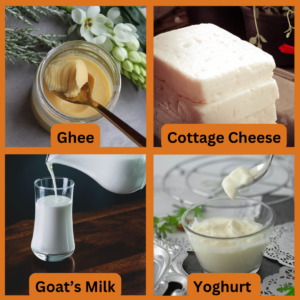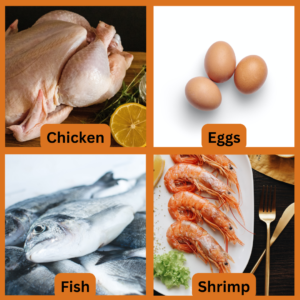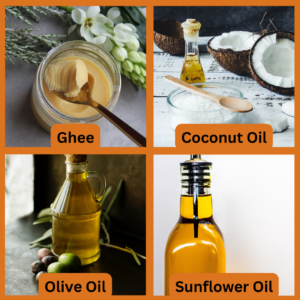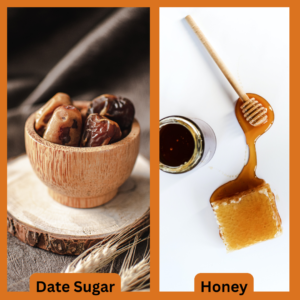Table of Contents
ToggleIntroduction:
As per the principles of Ayurveda, Vata is one of the three doshas that control the functioning of the body. Vata is the dosha that controls movement and communication in the body, and its balance is essential for maintaining overall health and wellness. When Vata dosha is aggravated, it can cause a variety of physical and mental symptoms such as dry skin, constipation, anxiety, and insomnia. One way to balance Vata dosha is through the consumption of Vaata pacifying foods.
The following are some Vaata pacifying foods that I recommend that can be incorporated into your diet to balance Vata dosha:
Fruits:
Fruits that pacify vaata will generally be sweet and nourishing. While some raw fruit is appropriate, cooked or stewed fruits are easier to digest and offer additional warmth, moisture, and sweetness—which makes them even more beneficial for vata. Fruits to avoid are those that are exceptionally cooling, astringent (drying), or rough, which includes most dried fruit (unless it has been soaked or cooked to rehydrate).
And remember, fruits and fruit juices are best enjoyed alone—30 minutes before, and ideally at least 1 hour after, any other food. This helps to ensure optimal digestion. Note: this rule does not apply to fruits we typically consider vegetables (avocados, cucumbers, tomatoes, etc.). You will find these fruits listed among the “vegetables.”
| Favour | Avoid |
|---|---|
|
|

Vegetables:
Vegetables that pacify vaata will generally be sweet, moist, and cooked. Root vegetables are especially beneficial because they grow underground, and are therefore supremely grounding and stabilizing for vaata. Avoid exceptionally dry, rough, and cold vegetables, including most raw vegetables. If you must have raw veggies, a salad, or any of the vata-aggravating vegetables, keep the quantities small and eat them at mid-day, when digestive strength is at its peak. A really thorough cooking or a well-spiced, oily dressing will help to offset some of the dry, rough qualities of these foods.
| Favour | Reduce or Avoid |
|---|---|
|
|

Grains:
Grains that pacify vata are generally sweet, nourishing, easily digested, and well-cooked. Mushy grains and puddings (things like oatmeal, cream of wheat and rice pudding) exemplify the smooth quality and, when sweetened and spiced, are often delicious comfort foods. Avoid grains that are exceptionally light, dry, rough, or especially dense and heavy. It is one or more of these qualities that gives the grains in the “avoid” column below, their capacity to disturb vata.
| Favour | Avoid |
|---|---|
|
|

Legumes:
Vata can enjoy a narrow selection of legumes, provided they are well-cooked and well-spiced. The beans that work best for vata are a little less dense, rough, and dry than other legumes. They tend to cook relatively quickly, are easily digested, and offer a grounding, nourishing quality. Many other beans are too dry, rough, and hard for vata’s delicate digestion.
| Favour | Avoid |
|---|---|
|
|

Dairy:
Dairy products are generally quite balancing for vata, but it’s good to avoid highly processed preparations (like powdered milk), especially cold dairy products. For example, boiled cow’s milk (ideally a non-homogenized variety) spiced with cinnamon and nutmeg, sweetened if desired, and served hot, is a tonic for vata, whereas cold cow’s milk may be too difficult for many to digest. As a rule, dairy milk (cow’s milk, goat’s milk, sheep’s milk, etc.) should be taken at least one hour before or after any other food. For this reason, avoid drinking milk with meals. Almond and rice milk are good substitutes, if you need to combine milk with other foods, or if you don’t digest dairy milk well.
| Favour | Avoid |
|---|---|
|
|

Nuts & Seeds:
In moderation, all nuts and most seeds are pacifying to vata. They are oily and nutritious, and they offer a power-packed combination of proteins and fats that are highly beneficial to vata. That said, nuts and seeds are quite heavy and should be eaten in small quantities so as not to overwhelm vats’ fickle digestive capacity.
| Favour | Avoid |
|---|---|
|
|

Meat & Eggs:
Vata does well with eggs and a variety of different meats if you choose to eat them. That said, vata can easily be pacified without these animal foods, if your diet doesn’t already include them. If you do eat meat, the meats to favour are those that are nourishing, sweet, moist, and relatively easy to digest. Meats to avoid tend to be either too light and dry, or too heavy, for vata.
| Favour | Avoid |
|---|---|
|
|

Oils:
Because toxins tend to concentrate on fats, buying organic oils may be more important than buying organic fruits and vegetables. Most oils are beneficial for vata, provided they are high-quality oils. Sesame oil, almond oil, coconut oil, olive oil, and ghee are among the best choices. Less favourable oils are either too light and dry, too difficult to digest, or too highly processed/altered for vata.
| Favour | Avoid |
|---|---|
|
|

Sweeteners:
Most sweeteners are good for vata, but it’s generally best to avoid large quantities of refined sugar. Favour sweeteners are in their most natural state over anything highly processed. For example, if you normally sweeten a cup of spiced milk with white sugar, try tossing your milk into the blender with a few soaked dates instead. Beyond that, sweeteners with warming energy like honey, jaggery, and molasses, are especially helpful in offsetting Vata’s tendency to be cold. But, honey is also quite scraping and can be depleting, if overused. When it comes to finding the specific choices that work best for you, it’s often helpful to experiment with a variety of options to sort out your body’s unique preferences.
| Favour | Avoid |
|---|---|
|
|

Spices:
Most spices are wonderful for vata, provided that none of your dishes is fiery hot (due to excessive use of cayenne pepper, chilli peppers, and the like). Experimenting with a wide variety of new and exotic spices is generally great for vata, and can help to kindle overall digestive strength.
| Favour | Use in Moderation |
|---|---|
|
|

Some tips for eating to balance Vata dosha:
When it comes to balancing Vata dosha, it’s not just about what you eat, but also how you eat. Below are some tips for eating in a way that balances Vata dosha:
Eat warm, cooked meals:
As mentioned earlier, warm, cooked meals are excellent for pacifying Vata dosha.
Eat at regular times:
Eating at regular times can help to balance Vata dosha’s erratic nature. Try to eat three meals daily at roughly the same time each day.
Avoid overeating:
Overeating can aggravate Vata dosha, leading to indigestion, bloating, and other digestive issues. Instead, eat until you are about 75% full, leaving some room for digestion.
Avoid cold and raw foods:
Cold and natural foods can aggravate Vata dosha, leading to digestive issues and other symptoms. Instead, opt for warm, cooked foods that are easy to digest.
Eat in a calm and peaceful environment:
Eating in a calm and peaceful environment can help to balance Vata dosha. Avoid eating while distracted or stressed and take the time to enjoy your meal.
Chew your food well:
Chewing your food well can help to improve digestion and reduce the risk of digestive issues. Take the time to chew your food thoroughly before swallowing.
Avoid eating on the go:
Eating on the go can aggravate Vata dosha, leading to indigestion and other digestive issues. Instead, take the time to sit down and enjoy your meal in a calm and peaceful environment.
Drink warm liquids:
Drinking warm liquids such as herbal teas can help to balance Vata dosha. Avoid cold or iced drinks, which can aggravate Vata dosha and lead to digestive issues.
Use warming spices:
Warming spices such as ginger, cinnamon, and cardamom can help to balance Vata dosha. Add these spices to your meals or drink them in warm beverages like tea.
Practice mindful eating:
Mindful eating involves paying attention to your food, savouring each bite, and enjoying the flavours and textures of your meal. Practising mindful eating can help to balance Vata dosha and improve digestion.
In addition to following a Vata pacifying diet and eating habits, managing stress and getting enough rest is essential. Stress can aggravate Vata dosha, leading to various physical and mental symptoms. Practices like yoga, meditation, and deep breathing can help to balance Vata dosha and promote overall health and well-being.
Conclusion
In conclusion, a Vata pacifying diet is an essential component of Ayurvedic medicine and can help to balance Vata dosha and promote overall health and well-being. Incorporating warm, cooked foods, healthy fats, sweet and sour fruits, root vegetables, grains, spices, and herbal teas can help to balance Vata dosha. Additionally, following mindful eating habits, managing stress, and getting enough rest can also help to balance Vata dosha and promote overall health and wellness.
